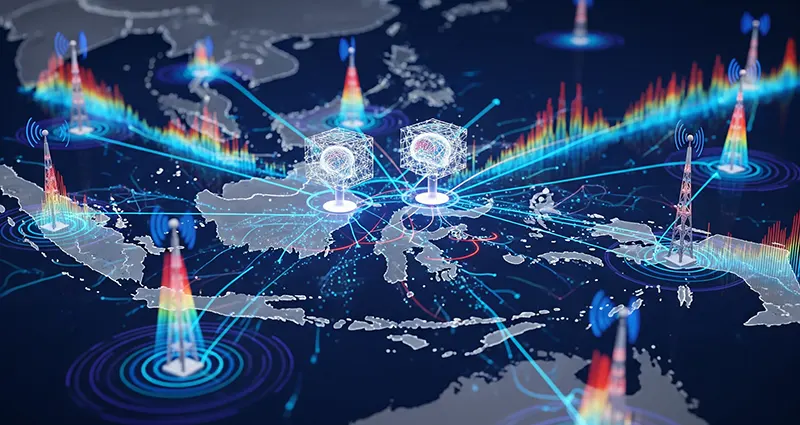The burgeoning demand for wireless connectivity in Indonesia, fueled by a rapidly growing digital economy and a geographically diverse landscape, places immense pressure on the limited radio frequency spectrum. Traditional static spectrum allocation methods struggle to keep pace with the dynamic needs of various applications and user demands, leading to spectrum scarcity and inefficient utilization. Cognitive Radio Networks (CRNs), empowered by Artificial Intelligence (AI), offer a promising solution for autonomous spectrum management, paving the way for more efficient and flexible use of the airwaves across Indonesia’s diverse regions.
The Spectrum Crunch in Indonesia:
Indonesia’s unique geographical characteristics, spanning thousands of islands, and its burgeoning digital adoption necessitate robust and efficient wireless communication infrastructure. However, the traditional approach of allocating fixed frequency bands to licensed users often results in:
- Spectrum Underutilization: Licensed bands can remain idle for significant periods while other unlicensed bands experience congestion.
- Limited Access for New Technologies and Services: Obtaining new spectrum licenses can be a lengthy and expensive process, hindering the deployment of innovative wireless services.
- Inefficiency in Handling Dynamic Demands: The static nature of spectrum allocation fails to adapt to fluctuating user traffic and the emergence of new wireless applications with varying spectrum needs.
- Challenges in Remote and Rural Areas: Providing reliable connectivity in geographically dispersed areas often faces challenges due to limited available spectrum.
Cognitive Radio Networks: An Intelligent Approach to Spectrum Management:
Cognitive Radio (CR) technology offers a dynamic and intelligent approach to spectrum management. A cognitive radio is an intelligent wireless communication system that can sense its environment, learn from it, and adapt its operating parameters (e.g., frequency, transmission power, modulation scheme) in real-time to improve communication efficiency and reliability.
The Synergistic Power of AI in Cognitive Radio Networks:
While the core concept of CR relies on spectrum sensing and dynamic adaptation, the integration of Artificial Intelligence (AI) is crucial for achieving truly autonomous and efficient spectrum management. AI algorithms empower CRNs with advanced capabilities such as:
- Intelligent Spectrum Sensing and Awareness: AI techniques like machine learning can analyze vast amounts of spectrum data to accurately identify available frequency bands, even in complex and noisy environments. This goes beyond basic energy detection to recognize primary user signals with higher accuracy and predict future spectrum availability.
- Autonomous Spectrum Decision-Making: AI algorithms can learn optimal spectrum access strategies based on various factors, including primary user activity, interference levels, QoS requirements of secondary users, and network policies. Reinforcement learning, for instance, allows CRs to learn the best actions to take in different spectrum scenarios through trial and error.
- Adaptive Resource Management: AI can dynamically adjust transmission power, modulation schemes, and other communication parameters based on the detected spectrum conditions and the needs of the communicating devices. This ensures efficient data transmission while minimizing interference to other users.
- Proactive Interference Mitigation: AI models can predict potential interference based on historical data and real-time spectrum sensing, enabling CRNs to proactively adjust their operating parameters to avoid or mitigate interference.
- Context-Aware Spectrum Access: AI can leverage contextual information, such as location, time, and user profiles, to make more intelligent spectrum access decisions. For example, a CR device in a rural area might have access to a wider range of frequencies compared to a device in a densely populated urban environment.
- Network Optimization and Collaboration: In multi-CRN scenarios, AI can facilitate collaboration and coordination among different CR devices to optimize overall spectrum utilization and avoid interference across the network.
Benefits of AI-Powered CRNs for Indonesia:
The development and deployment of AI-powered CRNs hold significant potential for addressing Indonesia’s spectrum management challenges and fostering greater connectivity:
- Enhanced Spectrum Efficiency: Dynamic spectrum access allows for better utilization of the available airwaves, enabling more users and applications to coexist without significant interference.
- Improved Connectivity in Remote Areas: CRNs can opportunistically utilize underutilized spectrum in rural and remote regions, providing much-needed connectivity to underserved communities.
- Faster Deployment of New Wireless Services: The ability to dynamically access spectrum can accelerate the rollout of innovative wireless technologies and services without lengthy licensing processes.
- Support for Diverse Applications: AI-powered CRNs can adapt to the specific spectrum requirements of various applications, from low-bandwidth IoT devices to high-bandwidth multimedia streaming.
- Increased Network Resilience: The ability to dynamically switch to available spectrum bands enhances the robustness of wireless networks in the face of interference or primary user activity.
- Cost Reduction: More efficient spectrum utilization can potentially reduce the need for extensive investments in new spectrum licenses.
Challenges and Steps Forward for Indonesia:
While the potential is substantial, the development and deployment of AI-powered CRNs in Indonesia face certain challenges:
- Regulatory Framework: Clear and adaptive regulatory frameworks are needed to facilitate the deployment of CR technology while protecting the rights of primary users. Collaboration between regulatory bodies and research institutions is crucial.
- Technological Complexity: Developing robust and reliable AI algorithms for spectrum sensing, decision-making, and adaptation requires significant research and development efforts.
- Implementation Costs: The initial investment in advanced hardware and software for CR devices and network infrastructure can be a barrier.
- Interoperability: Ensuring interoperability between different CR devices and existing wireless technologies is essential for seamless integration.
- Security Concerns: Robust security mechanisms are needed to prevent malicious secondary users from interfering with primary users or disrupting network operations.
- Developing Local Expertise: Investing in education and training to build a skilled workforce capable of developing, deploying, and managing AI-powered CRN systems is crucial for Indonesia’s long-term success in this field.
Moving Forward, Indonesia can focus on:
- Investing in Research and Development: Supporting local research institutions and universities in advancing AI and CR technologies tailored to Indonesia’s specific needs and challenges.
- Establishing Pilot Projects and Testbeds: Creating experimental platforms to evaluate the performance and feasibility of AI-powered CRNs in real-world scenarios across different regions of Indonesia.
- Fostering Collaboration: Encouraging partnerships between government agencies, telecommunication operators, technology providers, and research institutions to drive innovation and deployment.
- Developing Adaptive Regulatory Policies: Creating a flexible regulatory environment that encourages the adoption of CR technology while ensuring the protection of licensed spectrum users.
- Raising Awareness and Building Capacity: Educating stakeholders about the benefits and potential of AI-powered CRNs to foster wider adoption and build a skilled workforce.
Developing cognitive radio networks empowered by artificial intelligence offers a transformative opportunity for autonomous spectrum management in Indonesia. By enabling dynamic and intelligent use of the airwaves, AI-powered CRNs can address the growing demand for wireless connectivity, bridge the digital divide, and foster innovation across the nation’s diverse landscape. While challenges remain, a concerted effort involving government support, research advancements, industry collaboration, and adaptive regulatory frameworks will be crucial for harnessing the full potential of this technology and empowering Indonesia’s connected future. The intelligent management of its radio spectrum through AI-driven cognitive radio networks will be a key enabler for Indonesia’s continued digital transformation.











